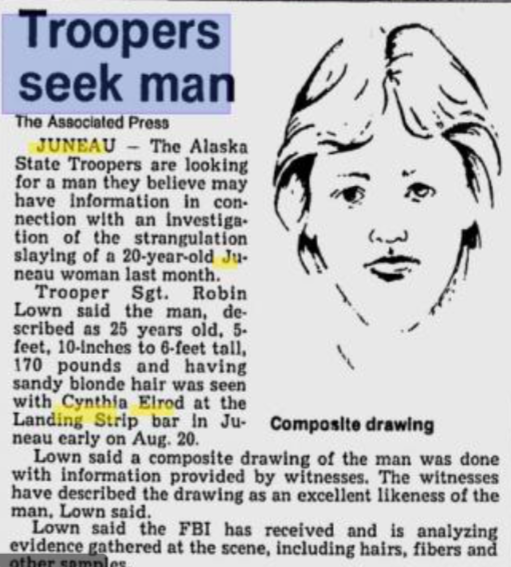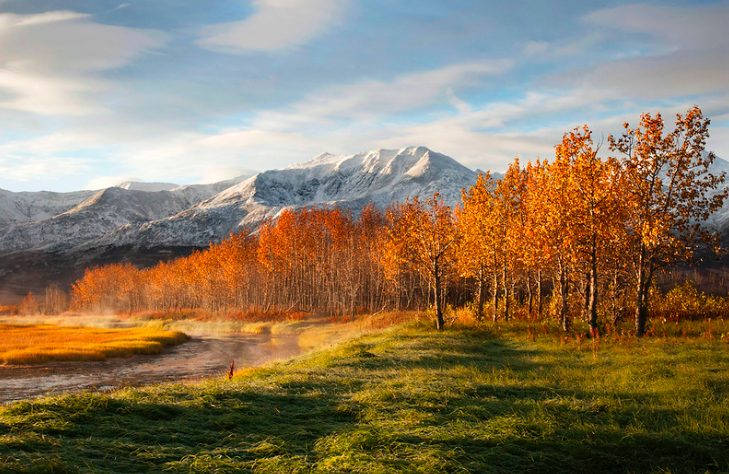MEN OUTNUMBER WOMEN ON COLD-CASE HOMICIDE, MISSING LISTS
A revamped web page went live last week at the Alaska Department of Public Safety.
The list is meant to keep the public better informed about cold-case and missing persons investigations, and encourage people to come forward to help solve some longstanding Alaska mysteries.
Of the 69 cold-case homicides on the unsolved list, Anchorage and Fairbanks tie for the most, with 14 cases each. Wasilla and Juneau have three cold cases each.
There are 38 men and 31 women listed as cold-case homicides.
Among the cold cases on the list is the nearly forgotten murder of Cynthia Elrod, age 20, in Juneau in August of 1983.
Elrod’s death gripped the capital city when she was found strangled in her Kodzoff Acres trailer; her killer was never identified, although a police artist sketched the likeness of a man she had been with at the Landing Strip bar a few days earlier.
According to news reports from the time, there were hair, fiber, and other samples collected at the time. Those could be analyzed today with advanced DNA technologies.

Investigators thought they has a lead in 1994, when they sent blood and hair samples taken from a Longview, Washington man to the state crime lab in Anchorage, but that lead went nowhere, and 36 years since the murder, the case remains unsolved.
Elrod is the only Juneau cold case on the Department of Public Safety statewide list, although there are other unsolved murders in Juneau.
“In a sense, we’re offering this revamped webpage as a call to action,” said Colonel Barry Wilson, Director of the Alaska State Troopers. “We’re hoping the public will be inspired to get involved and help put more of these cases to rest. Any new information, DNA as a family member or dental records which may be matched to newly or previously discovered remains that have gone unidentified, can bring closure to an investigation.”
As for the missing and unaccounted for, 109 of the cases are on a separate list on the state’s website.
Fairbanks has the most missing, with 27 missing, and Soldotna coming in second with 17. Anchorage has 9, Palmer has 7, and Juneau and Ketchikan have 6 each.
But when it comes to missing, there are far more men than women: 82 people on the list of 109 are men.
Visit the Cold Case Investigation Unit here.
Sometimes it’s obvious what happened. When footsteps lead to a hole in the ice, but no body is found, it’s evident the person went through the ice. Or when a plane goes missing in the wilds of Alaska and is never located, the missing person case can stay unresolved for years.
One individual on the “missing” list, Vladimir Kostenko, was the subject this week of Alaska writer Craig Medred, in a long-form story titled “Gone Guy.”
Kostenko has been missing for more than a year after he hiked off into the Talkeetna Mountains. An extensive search by Troopers and Kostenko’s friends turned up nary a clue as to what happened to him. But plenty of contradictions exist in the story which makes the Kostenko disappearance especially mysterious.
The Cold Case Investigation Unit was formed in 2002 and is overseen by the Alaska Bureau of Investigation to review and re-examine unsolved cases dating back as far as 1961.
With the advancement of DNA technology, the CCIU and the Missing Persons Clearinghouse have solved homicides and missing persons cases by working with victims’ family members who have come forward to provide their own DNA samples.
Recent arrests in three cold cases include Steven H. Downs, of Auburn, Maine, for the 1993 murder and sexual assault of Sophie Sergie; Donald McQuade, of Gresham, Oregon, in the 1978 sexual assault and murder of Shelley Connolly; and the identification of remains found in 1995 as those of Ronald Oquilluk, missing since 1987.
The 32-year hunt for Oquilluk, a special needs man living under supervision in Butte, ended in 2018, when DNA from his sister was sent to the national DNA clearinghouse. That DNA matched the one from remains found in 1996 near Central, many miles to the north, where Oquilluk had evidently ended his walkabout.
The story, documented by Ken Marsh in “Ronald Oquilluk’s Long Road Home” is a fascinating look at the efforts made by missing persons investigators to close cases.

Nice photo at the top of this story…
Love the contrasting fall colors in AK.
My best guess as to the number of missing men being so much larger than the number of missing women? Most of the missing men want to be missing. They have assumed new identities in a different community, probably far away.